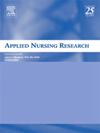家庭照顾者对脑血管及脊柱疾病患者压疮预防装置及设备的认知。
IF 2.2
4区 医学
Q1 NURSING
引用次数: 0
摘要
背景:家庭照顾者在预防脑血管和脊柱疾病患者的压疮中起着至关重要的作用。尽管有先进的设备,包括基于物联网(IoT)的智能床垫,但这些技术的采用和有效性受到护理人员的经验和看法的影响。目的:了解家庭护理人员对压疮预防器械和设备的体验和认知,重点分析影响家庭护理人员采用物联网智能床垫意愿的因素。设计:横断面调查研究。环境和参与者:159名脑血管和脊柱疾病患者的家庭照顾者,他们有使用压疮预防装置的经历。方法:本研究采用问卷调查的方式收集资料。进行描述性统计、频率分析和多元回归分析。结果:护理人员平均使用1.69种压疮预防设备,其中最常用的是坐垫(37.7%)和床垫(44.0%)。易用性和舒适性被确定为影响他们满意度的关键因素。结论:本研究结果表明可用性和数字包容对护理人员采用智能健康技术的重要性。建议采用以用户为中心的方法来开发设备,以更好地满足家庭照顾者的实际需求。本文章由计算机程序翻译,如有差异,请以英文原文为准。
Family caregivers' perception of pressure ulcer prevention devices and equipment for patients with cerebrovascular and spinal disease
Background
Family caregivers play a crucial role in preventing pressure ulcers in patients with cerebrovascular and spinal diseases. Despite the availability of advanced devices, including Internet of Things(IoT) based smart mattresses, the adoption and effectiveness of these technologies are influenced by caregivers' experiences and perceptions.
Objective
To investigate the experiences and perceptions of family caregivers regarding pressure ulcer prevention devices and equipment, with a focus on the factors influencing the intention to adopt IoT-based smart mattresses.
Design
A cross-sectional survey study.
Setting(s) and participants
159 family caregivers of patients with cerebrovascular and spinal diseases, who had experiences with pressure ulcer prevention devices.
Methods
Data for this study were collected through survey questionnaires. Descriptive statistics, frequency analysis and multiple regression analysis were conducted.
Results
Caregivers reported using an average of 1.69 types of pressure ulcer prevention equipment, with cushions (37.7 %) and mattresses (44.0 %) being the most commonly used. Ease of use and comfort were identified as key factors contributing to their satisfaction. The multiple regression model (R2 = 0.54, p < .001) revealed that ease of use (p < .01), perceived usefulness (p < .01), and perceived necessity (p < .01) were significant predictors of participants' intention to adopt smart mattresses. In addition, the number of digital devices owned by caregivers was positively associated with the intention to adopt smart mattress (p < .001).
Conclusions
The findings of this study show the importance of usability and digital inclusion in the adoption of smart health technologies by caregivers. A user-centered approach to device development is recommended to better meet the practical needs of family caregivers.
求助全文
通过发布文献求助,成功后即可免费获取论文全文。
去求助
来源期刊

Applied Nursing Research
医学-护理
CiteScore
4.50
自引率
0.00%
发文量
65
审稿时长
70 days
期刊介绍:
Applied Nursing Research presents original, peer-reviewed research findings clearly and directly for clinical applications in all nursing specialties. Regular features include "Ask the Experts," research briefs, clinical methods, book reviews, news and announcements, and an editorial section. Applied Nursing Research covers such areas as pain management, patient education, discharge planning, nursing diagnosis, job stress in nursing, nursing influence on length of hospital stay, and nurse/physician collaboration.
 求助内容:
求助内容: 应助结果提醒方式:
应助结果提醒方式:


